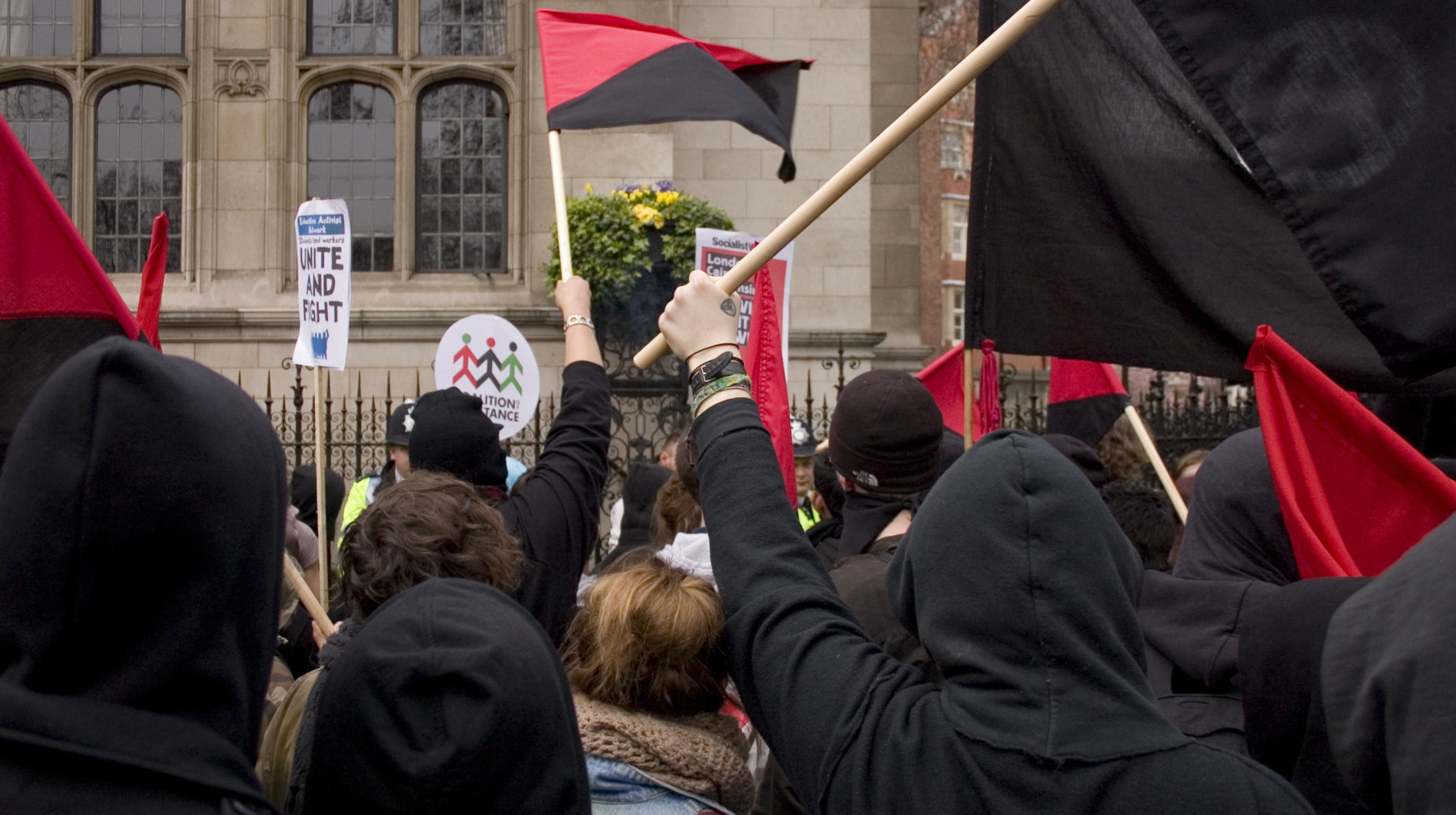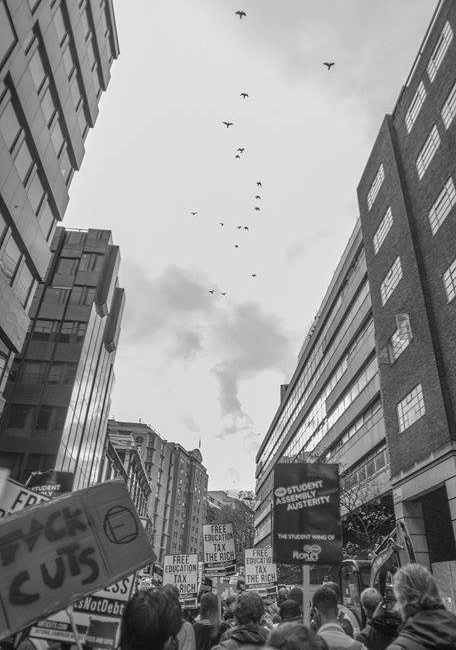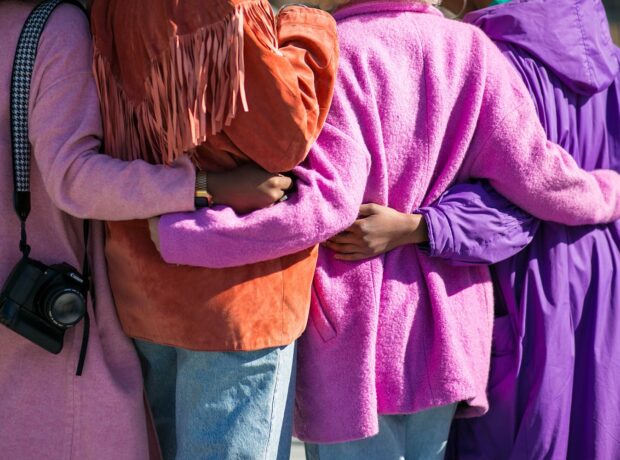At midday the atmosphere on Mallet Street outside UCL is defiantly optimistic despite the puddles left from the morning’s wet weather. Protesters in raincoats are handing out placards by the dozen and the road up to the demonstration is peppered on both sides by tents and people promoting different causes. It seems that every campaigning group in London has joined the protest. Whilst Free Education is the dominant presence, from where I stand I can see banners from Stop Sisi, Socialist Revolution, The People’s Assembly, Tax the Rich, Gay Rights and Save the NHS.
As a thumping rhythm from a samba band reverberates through the crowd, speakers with megaphones struggle to be heard. Even Shadow Chancellor John McDonnell’s cries of “Solidarity! Solidarity!” are scarcely audible from where I stand a mere ten feet away. It feels like I am in a crowd of thousands, around me are mostly students, but a few grey haired protesters intermingle and a lone Japanese man holds an umbrella adorned with emblems of the CND.
Within the hour I am marching through central London. I see old women on the pavements smiling at us as we pass, people in shop windows, joining in with the chants. “What do we want? Free education! When do we want it? Now!” and “Education for the Masses, not just for the ruling classes!”
I can feel the atmosphere of unity and strength. It seems to propel us forward. We pass Parliament and pause to direct more chanting at Downing Street. There are chants ridiculing a recent newspaper story of Cameron’s misadventures in Oxford with a pig’s head, as well as a few other overzealous gestures, but with the carnival feeling now in full flow I feel I am doing something worthwhile, principled, and also fun. This, I think to myself, is how democracy and free assembly, topics which are discussed daily at University, are supposed to feel!

As we leave Downing Street I find myself towards the rear of the march and turning around I’m confronted with a phalanx of perhaps 20 or 30 figures in black jump suits. The front row are bearing large flat shields coloured in red and black, covering them from knee to shoulder, as if they are Roman legionaries – these, I would later be told, are ‘the black bloc’. Whereas many independent groups are marching, each with their own message, this is the first group which appears distinct and separate from the rest of the protest. The ranks of banners and shields shut out the other protesters. Some regard them tentatively, but others go shoulder to shoulder without apparent concern. Approaching the rear of the group, it’s quickly apparent that many of them are in their mid to late teens, younger even than undergraduate students such as myself. I am marching with a photographer, an Italian familiar with the mass upheavals in Italy following 2008. He is in a heated dispute with one marcher over his face covering. The marcher says he must do this to protect his identity from the police.
Then we turn onto a one-way traffic system, very narrow, with lines of hundreds of police (including dog handlers) all the way up the street. The jump-suited figures produce eggs and paint bombs from their suits and lob them towards the officers. The reaction of the police on both sides is immediate, but reserved. The regimented lines withstand the missiles and hurry up the street either side of the black bloc. Meanwhile a ripple of excitement through the crowd has some moving away and others, many with cameras and press cards, darting towards the commotion. Coloured smoke is released from within the black bloc and erupts into the air. The rear of the protest is hurriedly deserted by the skinny jeans and parka jackets of students and populated by hooded men more comfortable with the actions of their comrades.
Between the first acts of violence and the scenes at the Department for Business Innovation and Skills (which will be covered by the papers the next day) there is a short walk during which the police form up in ranks to escort the black bloc on either side. They respond again with missile fire of eggs and paint bombs. By the time they reach the government department, both the protestors and the police are clearly expecting a scrap and nervous adrenalin runs through the crowd. I now see everywhere cameras, journalists, notepads and pencils, press-badges and microphones. It feels like every journalist in London has arrived here ready to record the decisive moment.

From within the crowd it begins as a series of shouts. Within moments I feel claustrophobic, as pushing breaks out between police and protesters within a few meters of where I stand and there’s a rush of bodies to and from the scene, mostly with cameras in hand. Dozens of journalists push through whilst police crews with their own recording equipment also dash behind the array of yellow hazard jackets which line the pavements. I now hear the beating of three police helicopters above, no doubt with their own monitoring equipment. Hundreds of camera phones, including my own, are now above the heads of the crowd.
Of the entire day these next moments are to be what is recorded in the newspapers. The lines have been drawn and the opposing teams have their audience. There are even ‘referees’- legal professionals dressed in orange jackets with ‘Legal Observers’ across their fronts in big bold letters. The waving of placards and chants of political demands has been replaced by a thousand lenses. A press conference has exploded out of the crowd ready for what I now realise is the main event.
Using all of my six feet to peer over the heads in front of me I see the two lines collide into one another. One in fluorescent yellow the other in black. The police give forceful two-handed shoves with bellows of “get back”. The black bloc reply with a smattering of randomly aimed kicks and punches. I do not see policemen retaliate in kind, but later reports of police violence circulate round the protesters, told in dramatic tones of outrage to suitably appalled audiences.
Officers point out targets to one another as if the mass of protesters were simply invisible
Very quickly the shields with which two dozen men charge police lines are stamped to pieces on the kerb. Behind the painted covers are only damp slabs of polystyrene. As I stand with the pavement and police to my left, I watch the military efficiency of what the police do. Orders flow up and down the lines and lips are pressed to two-way radios. Conga lines of police officers, each with their hands clinging to their colleagues jackets, act as a single column. Hands brushing my ears belong to officers pointing out targets to one another as if I, along with the mass of protesters, were simply invisible.
Neither I nor the people around me have any desire to join in with the black bloc, who chant slogans of “anti-capi-talisme”. We are not part of their quarrel with the police, the cause of which I do not know. I hear word from those around me that about ten meters in front they’d attempted to storm the government department. Then an order is given, whistles are blown and this is the signal for the police lines to slice through the crowd and cut it in two. I stand with the same confused purposelessness as the rest of the bystanders as we find ourselves abruptly penned in while the front of the protest disappears down the road.
Inside the kettle there is not much to do, but turn to your neighbour. Soon everyone in my part of the crowd is chatting and conversations spread between the police and the protesters.
Close up, the police are no longer just rows of massed uniforms. I can see faces spattered with paint and uniforms stained from smoke. These are alert faces preoccupied with their task. Up the line, towards the centre of the road, the black bloc are still attempting to fight their way out to be confronted by a newly arrived contingent of riot police armed with truncheons.
In front of me one student who says he’s from Manchester appeals to an officer who, when asked, givers his name as Pete. The student’s group has split up and the bus back to their university will leave at five. It’s already three o’clock. His pleas to be allowed to leave are met with a sympathetic shrug and an apology that the ‘kettle’ might not be opened until late into the evening. Another man with a scarf covering his nose and mouth initiates a muffled exchange with Pete about police cuts, “you gotta remember we’re really all on the same side” he offers. The man is dressed in what is seen as the official uniform of protest from Brazil to Egypt, black clothing, face covered and hood up. But his suggestion sounds as if it was spoken at a battle re-enactment rather than a protest. As if to say, ‘it’s all part of the programme’, when in fact most of us are standing around asking each other who the people are that seem to have hijacked what was ostensibly a student protest.
I now feel superfluous to a demonstration that has no further need of me
By now anyone with a press-badge is dodging under the police lines. Those with the responsibility of conveying events to the general public are treated as important. To the bemusement of my acquaintance from Manchester they are patted through like officials at a security checkpoint, disappearing one by one presumably to find another livelier spotlight than where I stand. I now feel superfluous to a demonstration that has no further need of me. The majority of faces in the crowd are nervous, but also glum. It doesn’t take long, before restlessness sets in. Inside the kettle there are perhaps a couple of hundred people and when calls to ‘push’ finally domino across the crowd, the policemen are already lowering their arms. Before we even have the opportunity to give Pete an apologetic shrug and a hard shove he abandons his post, as the single line of police dissolves before the crowd.

Footage taken of the episode shows the aimless and senseless stampede that overtook the crowd when the kettle opened. I charge down the road with the others, for perhaps 500 meters. The wearers of the black suits are now tearing them off to make their escape up the road. For anyone else the only apparent reason for running is that if you didn’t you’d be left behind. And getting a glimpse of a little more exciting violence is probably better than sitting around for a few hours waiting for the bus to take you back to campus. The police chase down and handcuff certain people who had been involved in the scuffles and crowds of protesters then surround the police doing the arresting, partly to boo or chant, but mostly just to watch, like the camera crews.
Wherever there are arrests or small clashes, cameras descend on the scene
Interviews with protesters are conducted in the street. Wherever there are arrests or small clashes, cameras descend on the scene for a few seconds and then disperse again searching for another image to send to the newspapers. After witnessing a handful of these episodes I start to realise that the more radical protestors had surely wanted this to happen – to get their message in the news. If the protests had unfolded peacefully many people that day would have gone home disappointed, protestors, journalists, even no doubt some of the police, but the event would probably have passed very much unnoticed outside of London.
After leaving the protests I sit chatting with a friend just north of Vauxhall Bridge as a convoy of police vans, from which I had watched hundreds of police earlier unload, creep past, their wheels rolling over battered and torn banners calling for Free Education.
Thinking back to the march, I realise I had become a spectator more than a demonstrator. I had watched black-clad anonymous figures who had come prepared for a fight from the very beginning. Their black suits and cobbled together combat shields had been an advert to the police who had been out in force and waiting for them from the beginning. The majority of students, many who like me had come to march for the first time and take political action against their looming indebted futures, had been used by the black bloc, who needed us to legitimize their own actions.
The footage which I watched the next day predictably showed pictures only of uniformed mobs in clashes fit for revolution. But on the peripheries of these images, out of sight and mind were thousands of young adults like me who watched deflated as the calls for free education were forgotten. On the front pages of newspapers our banners and choruses became red flags, black hoods and cries for the ‘downfall of the capitalist system’. When the contingent of anarchist revolutionaries had appeared at the protest with their shields and smoke cans everyone knew what they had come for. As it turned out the police, the journalists, the cameras even the legal observers had all come for the same thing and, as one protester forlornly explained to me, “this happens every year”.
It’s disconcerting to see news footage being taken beside you, and then watching it the next day. The ‘story’ was representative of the events of the previous day only as a strange dramatic montage. As if the best bits had been edited together like an action-movie sequence. To appear in the show, you had to dress in the correct uniform and act out a role pre-approved by a protest narrative which I realised I had read time and time again. Those like me who’d joined the crowds for the first time despite forming the bulk of the demonstration were marginal in this narrative. No wonder the crowds often don’t get any bigger than a few thousand, despite the fact that the issues seriously affect millions. All that’s needed is for the crowd to be just big enough to stretch to the back of a photograph. Then the organisers can claim that many thousands came, and this is just as credible as the police and government claims for far fewer.
Did the protest cast even a small spotlight on David Cameron’s decision to change the maintenance grant for poor but talented students into another huge debt? When he arrived in the office the next morning did he find his aides demanding that he give the public answers to embarrassing questions raised by a popular student movement. It seemed to me that instead the protest had replaced the politics.
NCAFC are currently in the process of organising a nationwide student strike through Student Union resolutions and a national student ballot. I don’t hesitate in predicting that a mass student strike will not happen. Especially when the few thousand students who do turn up to the annual national demo find their type of protest is so readily ignored, even within their own movement. What of the heralded return of protest power in the 21st century? A power which has, in the last few years, toppled regimes and sparked civil wars. Well if it doesn’t look like an action film, frankly nobody in the media wants to know. What makes modern protest different is the newfound ability for news organisations to bring a press conference into a punch up.
Andrea Giudici is a second year undergraduate student at Warwick University studying Physics. A published photographer, his blog can be found on 1x.com.
Banner photo by Dominic Alves. Photos by Andrea Giudici.








